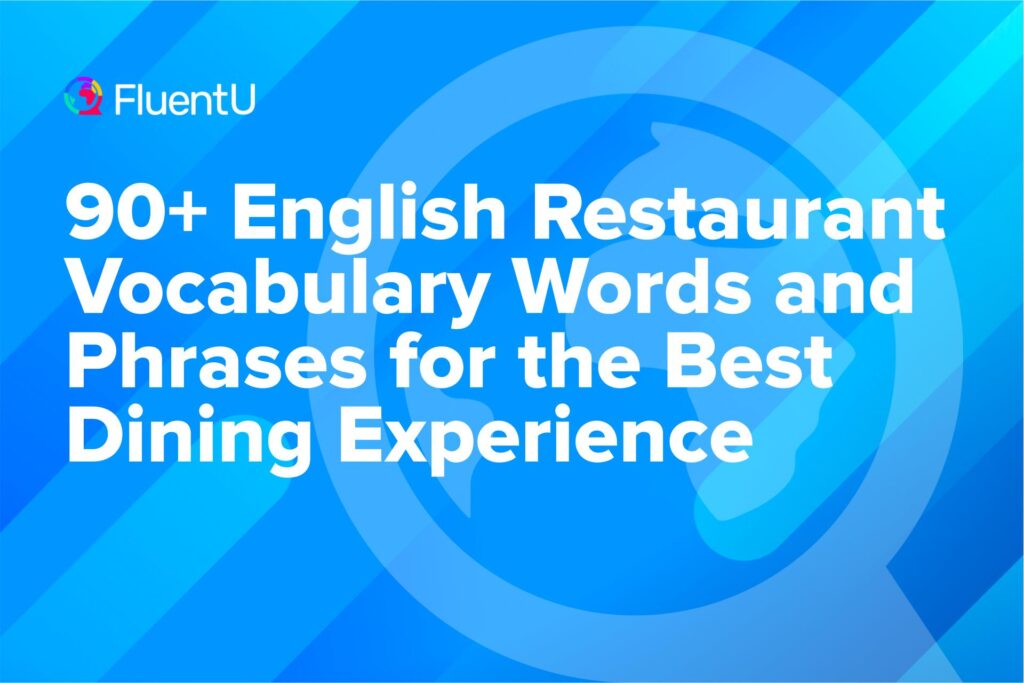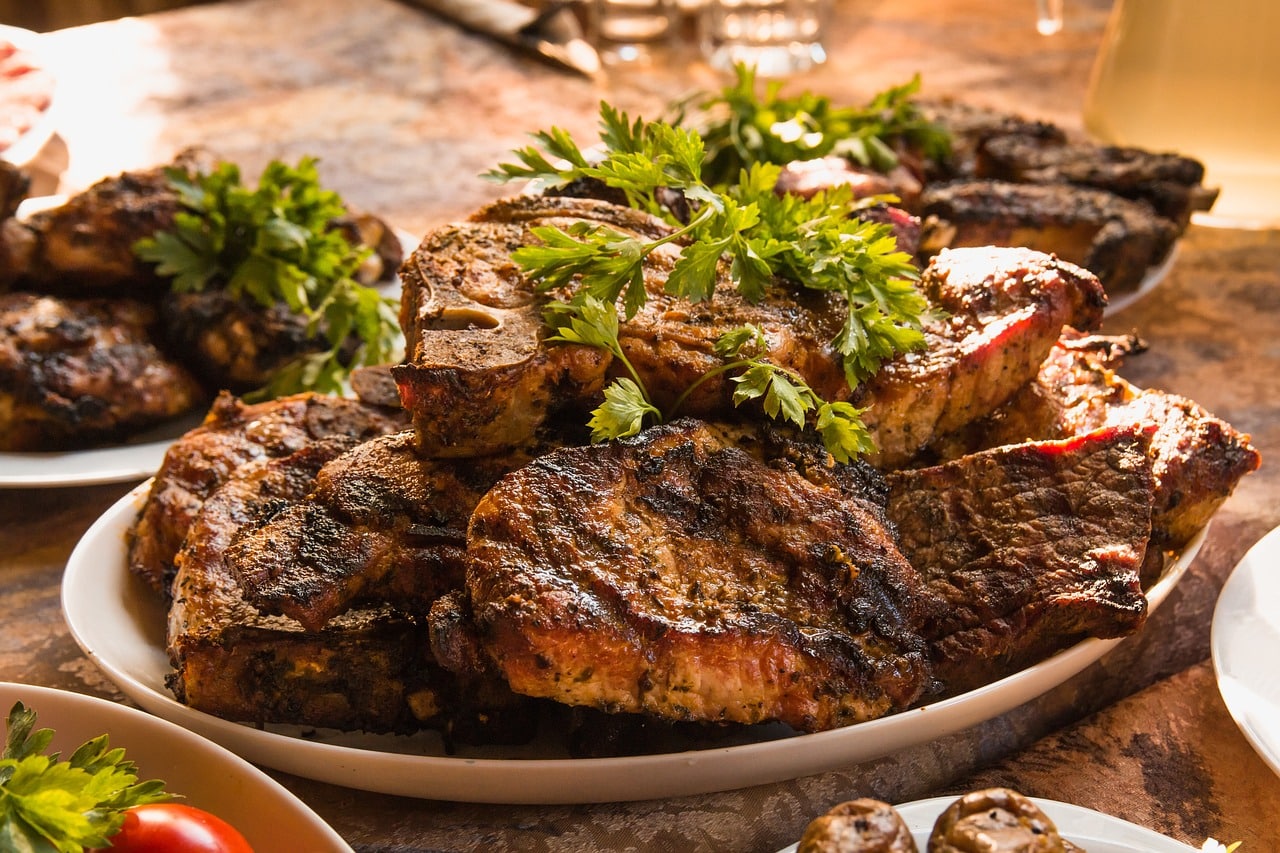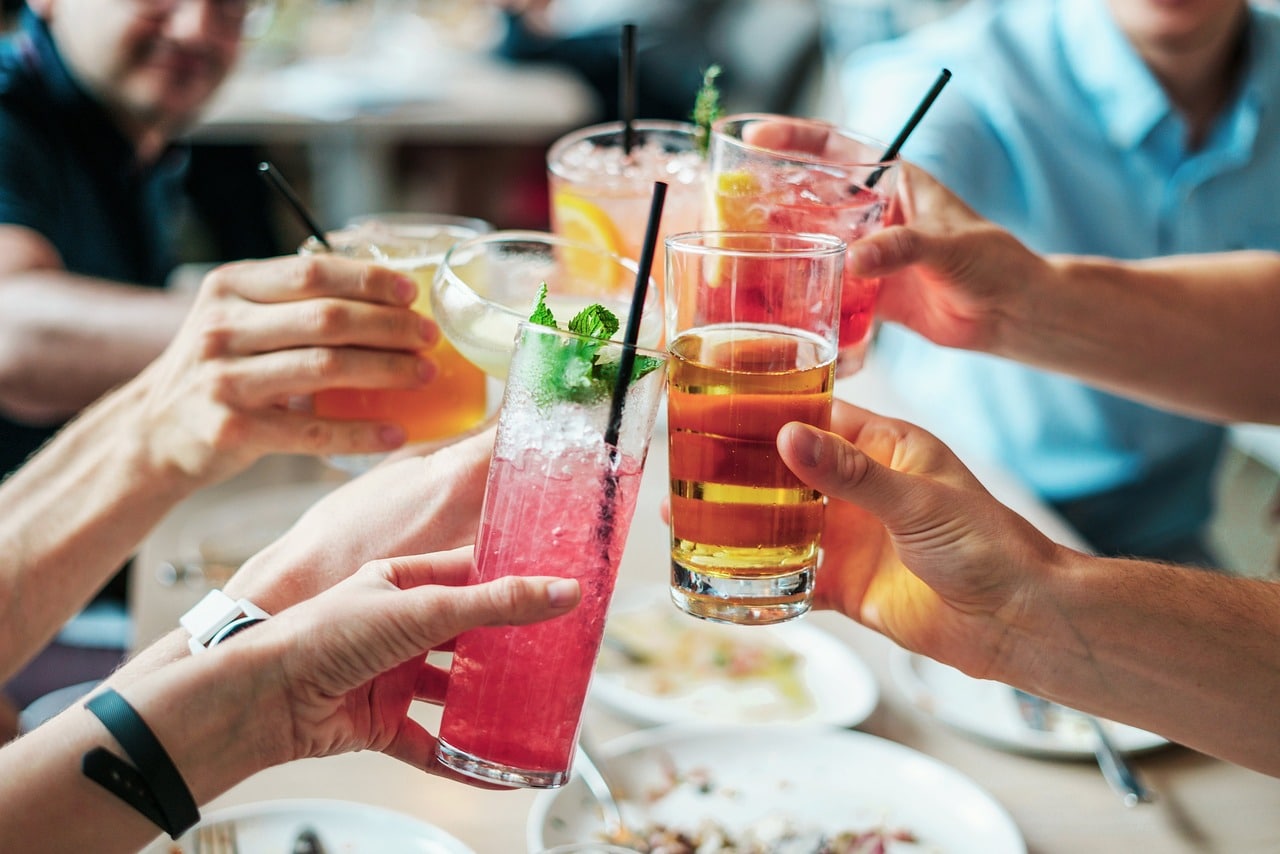90+ English Restaurant Vocabulary Words and Phrases for the Best Dining Experience

Eating at a restaurant is a wonderful and relaxing experience when you know all the right phrases. This guide covers everything you need, from making reservations to paying for the bill.
I’ll take you through over 90 vocabulary words, phrases and sentences in English that you’ll need when dining out.
Download: This blog post is available as a convenient and portable PDF that you can take anywhere. Click here to get a copy. (Download)
English Vocabulary for Eating at Restaurants
As the person in the family who’s responsible for buying groceries and cooking all the meals, I sometimes need a break. Eating out at a restaurant is a fun treat! It’s a great way to try new food and enjoy a meal that you didn’t have to cook for yourself.
If you’re learning English, going out to eat at a restaurant in an English-speaking place might seem a little scary. You can prepare before you go by learning these common English vocabulary words for eating at a restaurant:
- Al dente — Pasta cooked to be firm to the bite, not overly soft or mushy.
- Appetizer — A small dish served before the main course.
- Baked — Food cooked by dry heat in an oven.
- Beverage — A drink, such as water, soda, juice, coffee or tea.
- Bill / Check — A written statement of the total cost of a meal, including food and drinks.
- Bitter — Food that has a sharp and unpleasant taste, such as dark chocolate or certain vegetables.
- Buffet — A self-service style of dining where customers can fill their own plates from a variety of dishes.
- Chef — A professional cook who prepares meals in a restaurant.
- Condiments — Sauces, spices or toppings used to enhance the flavor of food.
- Cutlery — Utensils used for eating, such as forks, knives and spoons.
- Dessert — A sweet dish or treat served after the main course.
- Farm to table — Made from fresh ingredients from local farms and producers.
- Fresh — Food that’s newly harvested, recently made or not preserved.
- Fried — Food cooked in hot oil until crispy and golden.
- Gluten-free — Food that doesn’t contain gluten, suitable for those with dietary restrictions.
- Grilled — Food cooked over direct heat, often resulting in char marks.
- Hearty — Food that’s filling and satisfying.
- Host / Hostess — A person who greets and seats customers at a restaurant.
- Juicy — Food, particularly meat, that’s moist and full of flavor.
- Locally sourced — Food that’s obtained from nearby or local farms or producers.
- Main course — The primary dish in a meal, typically consisting of meat, fish or a vegetarian option.
- Marinated — Food soaked in a seasoned liquid to enhance flavor and tenderness.
- Medium — Food, particularly meat, cooked to a moderate level of doneness, usually with a slightly pink center.
- Melt-in-your-mouth — Food that’s incredibly tender and easily breaks apart.
- Menu — A list of food and drink options available at a restaurant.
- Mild — Food that has a subtle and gentle flavor, not spicy or overpowering.
- Napkin — A cloth or paper used for wiping the mouth and hands while eating.
- Organic — Food produced without the use of synthetic pesticides, fertilizers or genetically modified organisms (GMOs).
- Rare — Food, particularly meat, cooked for a short time to retain a pink or red center.
- Reservation — A prior arrangement to secure a table at a restaurant.
- Roasted — Food cooked in an oven or over an open flame until browned and cooked through.
- Sautéed — Food cooked quickly in a small amount of oil or fat over high heat.
- Savory — Food that’s flavorful and not sweet.
- Seafood — Edible aquatic animals, such as fish, shrimp or oysters.
- Seasonal — Food that’s available during a specific time of the year when it’s at its peak freshness.
- Simmered — Food cooked gently over low heat in a liquid, allowing flavors to meld.
- Sour — Food that has a tangy or acidic taste, often from citrus or vinegar.
- Special — A dish that’s unique or featured for a specific day or occasion.
- Spicy — Food that has a strong and pungent flavor from the use of spices or hot peppers.
- Sweet — Food that’s sugary or dessert-like in taste.
- Table — The furniture around which customers sit to eat their meals.
- Takeout — Food ordered from a restaurant to be consumed somewhere else.
- Tip — An additional amount of money given to the server as appreciation for good service.
- Vegan — Food that doesn’t contain any animal products, including meat, dairy and eggs.
- Vegetarian — Food that does not contain animal meat.
- Waiter / Waitress — A person who serves food and drinks to customers at a restaurant.
- Well-done — Food, particularly meat, cooked thoroughly with no pink or redness.
- Zesty — Food that has a lively and tangy flavor, often from the addition of citrus or spices.
Useful Restaurant Phrases in English
Making a Reservation
When a restaurant is popular, you can usually make a reservation to avoid waiting when you get there. This means you’ll have a table waiting for you at a certain time. All you have to do is show up!
Use these phrases when making a reservation either over the phone or in person:
- Hello, I would like to make a reservation.
- Can I make a reservation for tonight?
- I would like to reserve a table for [number] people.
- Do you have any tables available for [time]?
- We would like a table for [number] at [time].
Before you make an official reservation, you may want to know some details about the restaurant. Here are a few common phrases for that:
- Is there a dress code for the restaurant?
- Are you open for lunch or dinner?
- Do you serve breakfast all day?
- Are there any happy hour specials or discounts?
- Do you have any vegetarian or vegan options on the menu?
- We have some dietary restrictions. Can you accommodate them?
- Are children allowed in the restaurant?
- Is there parking available nearby?
- Can you accommodate a wheelchair?
- Do you have highchairs or booster seats for children?
- Can we bring our own wine, and is there a corkage fee?
Once, my family and I ate at a restaurant where we sat by the kitchen, and the strong smell of hot pepper made our eyes water! You can avoid an uncomfortable experience like this, or improve your experience even more, by asking for specific details during your reservation:
- We would like to reserve a table by the window.
- Can we have a table outside, please?
- We would prefer a table away from the kitchen, if possible.
You finished making the reservation, but realized that you need to make some changes to it. No problem! Here are some common phrases you might need to use:
- Can I change the reservation to [time]?
- I would like to cancel my reservation.
- We’re running a bit late for our reservation.
- Can I add one more person to our reservation?
Arriving at the Restaurant and Getting Seated
You’ve arrived at the restaurant! Now what?
Many restaurants have a host or hostess who will answer any questions you have and take you to your seat. Some common phrases you might need to know at this point include the following:
- Hello, we have a reservation under the name [name].
- Hello, we’d like a table for [number of people], please.
- Do you have any available tables at the moment?
- Is there a waitlist? How long is the wait?
- We would like to be seated, please.
- Can you show us to our table?
- Can we order takeout instead of dining in?
You might also hear these phrases said to you. Read them now so you’ll be able to recognize and understand them:
- Good evening! Do you have a reservation?
- Welcome to [Restaurant Name]. How many are in your party?
- Hi there! Would you like a table or a booth?
- Do you prefer indoor or outdoor seating?
- Follow me, please. I’ll show you to your table.
- This way, please. Your table is ready.
- Here’s our menu. Feel free to take a look.
Phrases for Ordering Food
You’re taken to your seat and are almost ready to order. Usually, the menus will be waiting for you at your table, but you can also ask for it using these phrases:
- May we see the menu, please?
- Can we see a drinks menu, as well?
- Is there a children’s menu available?
Once you have a seat and have had a chance to look over the menu, the waiter will come by and ask if you’re ready to order. Here are some phrases you’ll hear:
- Can I get you anything to drink while you look over the menu?
- May I take your order?
- Can I start you off with some drinks or appetizers?
- Are you ready to order, or do you need a few more minutes?
Not sure what to get? Ask your waiter/waitress for a recommendation!
- Could you recommend any specials for today?
- Do you have any house specialties?
- Can you recommend a popular dish?
- Can you recommend a good wine pairing for the [dish name]?
- What do you recommend for someone who enjoys seafood?
- Could you tell me more about this dish?
- Are there any daily specials or promotions?
If you’re like me, you have friends and family with dietary restrictions. It’s always a good idea to ask about the ingredients in a dish before you order, if anyone in your dining party needs to be aware of allergens or if you need to know how a meal is cooked for a diet.
- Is it possible to customize the dish to accommodate dietary restrictions?
- What are the allergens in this dish?
- Do you have any gluten-free options?
- Are there any nuts in this dish?
- I have a seafood allergy. Can you recommend something safe for me to eat?
- Are there vegetarian or vegan options available?
- Can you accommodate a dairy-free diet?
- Do you have any low-sodium options?
Finally, you’re ready to place your order. Here are some useful phrases you can use:
- I would like to place an order, please.
- We’d like to start with some appetizers.
- Can I have the [dish name], please?
- How is the [dish name] prepared?
- Is the [dish name] served with any sauce?
- Can I have the dressing on the side?
- Can I get extra cheese on my burger?
- Can I substitute mashed potatoes for fries?
- Is there an option to add avocado to my sandwich?
- I’ll take my steak cooked medium rare, please.
- Can you make it a combo meal with a drink and fries?
- Can I have the [dish name] without onions?
- Can I have my eggs sunny-side up?
- Could I have some extra napkins, please?
- Can I have a glass of water with lemon, please?
- Can I have a refill on my soda?
- Is this dish spicy?
- Can you make the [dish name] spicy?
- Can you make sure my food is not too spicy?
- Can I have the [dish name] to go, please?
The meal is done. Time for dessert!
- Can I see the dessert menu, please?
- What is your most popular dessert?
- Do you have any gluten-free or vegan dessert options?
- The dessert looks amazing. Can we get one of each, please?
During the Meal
As you eat, your waiter might come around to see how everything is. You’ll hear these phrases:
You can also call the waitress over to ask for assistance during the meal.
- Could we have some more napkins, please?
- Is it possible to get some extra utensils?
- Could we get some more water, please?
- Can we have some extra napkins, please?
- Is it possible to get some more bread?
- Is it possible to get some more sauce on the side?
- Can we have some more ice for our drinks?
- Could we get some extra utensils, please?
- Can we have some more salad dressing?
- Can you bring some extra plates for sharing?
- Could we get a box for the leftovers, please?
I talk about some issues you might have later in this post, but if you’re enjoying your meal, let the waitstaff know! They’re probably used to complaints, and a nice heartfelt compliment (and a generous tip!) could make their day.
- This dish is delicious!
- The service here is excellent.
- This steak is cooked perfectly.
- The food presentation is beautiful.
Asking for the Check
Whenever I’m out with my friends, we have one person in charge of deciding how much everyone will pay. To save time, figure out if you’re splitting the bill and how you’re doing it.
To ask for the check, use these English phrases:
- Excuse me, could we get the check, please?
- Can we have the bill, please?
- We’re ready to settle up. Could you bring us the check?
- Can you split the bill between two cards?
- Is it possible to split the bill between multiple people?
- Can we have separate checks?
- Do you accept credit cards?
- Can I pay with cash?
- Is the service charge included in the bill?
- Can I get a receipt?
Resolving Common Problems
Unfortunately, your restaurant visit isn’t always perfect and you may have an issue during your meal. Here are some common problems and how you can politely ask for help resolving them:
- There was a mistake with the reservation. Can you assist us?
- Excuse me, but I think we received the wrong order.
- I’m sorry, but this dish is too salty/spicy for my taste.
- We’ve been waiting for our food for quite some time. Is everything okay?
- I ordered the steak medium-rare, but this is well-done.
- I asked for no onions, but there are onions in my meal.
- Excuse me, we didn’t receive the side dish we ordered.
- I have a food allergy, and I think there might be cross-contamination.
- Could we have a table in a quieter area?
- This plate is dirty. Could we have a replacement, please?
- We’ve been waiting a while for our check. Could you bring it, please?
- This chair is broken. Could we have another one, please?
- I’m not satisfied with the service we’ve received. Is there a manager we can speak to?
- We were overcharged for an item on our bill. Could you please rectify it?
Sample English Conversations at a Restaurant
Let’s put it all together! Here are three example English conversations you might have at a restaurant.
Conversation 1: Ordering Food
Waiter: Good evening! Welcome to our restaurant. Are you ready to order?
Customer: Yes, I’d like to start with a Caesar salad, please.
Waiter: Certainly. And for your main course?
Customer: I’ll have the grilled salmon with roasted vegetables.
Waiter: Great choice. Anything else?
Customer: Yes, I’d also like a glass of red wine to accompany my meal.
Waiter: Perfect. I’ll get that for you right away.
Conversation 2: Asking for Recommendations
Customer: Hi there! We’re looking for some recommendations. Can you tell us about tonight’s specials?
Waiter: Absolutely! Today we have a delicious lobster bisque as our soup of the day, and our chef’s special is a mouthwatering prime rib served with mashed potatoes and seasonal vegetables.
Customer: Both options sound tempting. Could you tell us more about the prime rib? How is it cooked?
Waiter: Our prime rib is slow-roasted for tenderness and cooked to medium-rare perfection. It’s a popular choice among our customers.
Customer: That sounds delicious. We’ll go with the prime rib, please.
Conversation 3: Paying the Bill
Customer: Excuse me, we’re ready to pay the bill.
Waiter: Certainly, I’ll bring it right over. Here’s your bill. Would you like to pay together or separately?
Customer: We’ll pay together, please. Could we also get a receipt?
Waiter: Of course. I’ll process the payment for you, and I’ll bring the receipt along with your change in a moment.
Customer: Thank you so much for your service. We had a lovely dining experience.
Waiter: You’re very welcome. It was my pleasure serving you. Have a wonderful day!
If you want more conversational examples, you’ll find them over on FluentU, along with hundreds of other English videos paired with learning tools.
FluentU takes authentic videos—like music videos, movie trailers, news and inspiring talks—and turns them into personalized language learning lessons.
You can try FluentU for free for 2 weeks. Check out the website or download the iOS app or Android app.
P.S. Click here to take advantage of our current sale! (Expires at the end of this month.)

With all these vocabulary words, phrases and even practice conversations, you’re ready to head out to that English-speaking restaurant. Enjoy your meal!
And One More Thing...
If you like learning English through movies and online media, you should also check out FluentU. FluentU lets you learn English from popular talk shows, catchy music videos and funny commercials, as you can see here:
The FluentU app and website makes it really easy to watch English videos. There are captions that are interactive. That means you can tap on any word to see an image, definition, and useful examples.
For example, when you tap on the word "searching," you see this:
Learn all the vocabulary in any video with quizzes. Swipe left or right to see more examples for the word you’re learning.

FluentU helps you learn fast with useful questions and multiple examples. Learn more.
The best part? FluentU remembers the vocabulary that you’re learning. It gives you extra practice with difficult words—and reminds you when it’s time to review what you’ve learned. You have a truly personalized experience.
Start using the FluentU website on your computer or tablet or, better yet, download the FluentU app from the iTunes or Google Play store. Click here to take advantage of our current sale! (Expires at the end of this month.)













